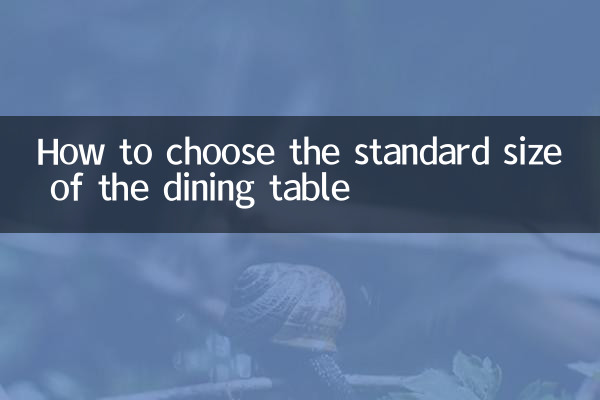How to choose the standard size of the dining table
When decorating a home or purchasing furniture, the size of the dining table is an overlooked but very important detail. The right dining table size not only enhances the dining experience, but also perfectly integrates with the space layout. The following is a detailed guide on the selection of standard table sizes, compiled from popular topics and hot contents across the network in the past 10 days.
1. Common dining table types and applicable scenarios

Dining tables are of a variety of types, with different shapes and sizes suitable for different family needs and space sizes. Here is a comparison of mainstream dining table types:
| Dining table type | Standard size range | Applicable scenarios | Pros and cons |
|---|---|---|---|
| Rectangular dining table | 120-240cm (Length) × 80-100cm (Width) | 4-8 people family, formal restaurant | High space utilization rate, but large space for activity |
| Round dining table | Diameter 90-150cm | Small apartment, 3-6 people | The atmosphere is warm, but the space utilization rate is low when placed against the wall |
| Square dining table | 90-120cm×90-120cm | Small family of 2-4 people, breakfast area | Save space, but not convenient for multiple people to eat |
| Retractable dining table | Contracted state 120cm, 180-220cm after stretching | A family with limited space but flexibility | Strong flexibility, but slightly poor structural stability |
2. Select the dining table size according to the number of people eating
The core choice of dining table size is the number of family residents and possible entertainment needs. The following are detailed suggestions:
| Number of people eating | Minimum dining table size | Comfortable dining table size | Space required for each person |
|---|---|---|---|
| 2 people | 75×75cm | 90×90cm | 60-75cm width |
| 4 people | 90×90cm | 120×80cm | 60-75cm width |
| 6 people | 140×80cm | 160×90cm | 60-75cm width |
| 8 people | 180×90cm | 200×100cm | 60-75cm width |
3. The proportional relationship between restaurant space and dining table
When choosing a dining table, you must consider the actual space size of the restaurant. The following is the recommended space ratio by professionals:
| Restaurant area | Maximum dining table size | Recommended dining table type | Reserve space for activities |
|---|---|---|---|
| 8-10㎡ | 120×80cm | Small rectangular or round | At least 80cm channels are left around |
| 10-15㎡ | 160×90cm | Standard rectangular or oval | Main channel is left with more than 100cm |
| 15-20㎡ | 200×100cm | Large rectangular or expandable | 120cm of activity space is left around |
| More than 20㎡ | 240×110cm | Banquet or custom dining table | Island assist can be set |
4. Standard height of dining table
Regardless of the shape and size of dining tables, height is a key factor in the comfort of dining:
| Dining table type | Standard height | Applicable chair height | Things to note |
|---|---|---|---|
| Regular dining table | 72-76cm | 45-50cm | Keep a 27-32cm gap with the dining chair |
| Bar table | 90-105cm | 60-75cm | Need to be used with a barrest |
| Children's dining table | 55-65cm | 30-40cm | Growth adjustment function needs to be considered |
5. Table purchasing trends in 2023
Based on recent hot topics and consumer feedback, the following are the current trends in table shopping:
1.Multifunctional design: The demand for dining tables with storage functions and dining tables that can be changed into workbenches has increased.
2.Environmentally friendly materials: Consumers prefer sustainable materials such as recycling wood and bamboo dining tables.
3.Smart Elements: The dining table with built-in intelligent functions such as wireless charging and temperature adjustment is popular among young families.
4.Minimalist style: The dining table design with simple lines and no complex decoration continues to be popular.
5.Customized services: The demand for customized dining tables for special apartment types and irregular spaces has increased.
6. Actual purchase suggestions
1. When measuring the actual size of the restaurant, consider details such as the opening direction of the doors and windows, the heating position, etc.
2. When experiencing the model room, simulate the actual dining scene and test whether the activity space is sufficient.
3. Consider the special needs of family members. If there are elderly people and children, the rounded corner design is safer.
4. When shopping for dining tables online, be sure to confirm whether the packaging size can pass through the corridor and elevator.
5. Leave room for family changes in the next 3-5 years, such as planning to have children or parents live together.
Choosing the right dining table size requires comprehensive consideration of multiple factors such as the number of family members, the size of the restaurant space, usage habits and future changes in demand. Hopefully this guide will help you make informed choices to create a comfortable and practical dining space.

check the details

check the details